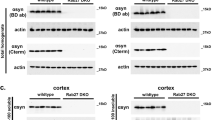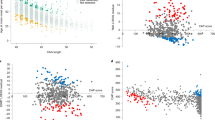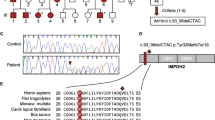Abstract
We have applied the technique of exon amplification to the isolation of genes from the chromosome 4p16.3 Huntington's disease (HD) candidate region. Exons recovered from cosmid Y24 identified cDNA clones corresponding to the α–subunit of adducin, a calmodulin–binding protein that is thought to promote assembly of spectrin–actin complexes in the formation of the membrane cytoskeleton. α–adducin is widely expressed and, at least in brain, is encoded by alternatively spliced mRNAs. The α–adducin gene maps immediately telomeric to D4S95, in a region likely to contain the HD defect, and must be scrutinized to establish whether it is the site of the HD mutation.
This is a preview of subscription content, access via your institution
Access options
Subscribe to this journal
Receive 12 print issues and online access
$209.00 per year
only $17.42 per issue
Buy this article
- Purchase on Springer Link
- Instant access to full article PDF
Prices may be subject to local taxes which are calculated during checkout
Similar content being viewed by others
References
Martin, J.B. & Gusella, J.F. Huntington's disease: Pathogenesis and management. New Engl. J. Med. 315, 1267–1276 (1986).
Gusella, J.F. Huntington's disease. Adv. hum. Genet. 20, 125–151 (1991).
Gusella, J.F. et al. A polymorphic DNA marker genetically linked to Huntington's Disease. Nature 306, 234–238 (1983).
MacDonald, M.E. et al. Recombination events suggest possible locations for the Huntington's disease gene. Neuron 3, 183–190 (1989).
Bates, G.P. et al. Defined physical limits of the Huntington disease gene candidate region. Am. J. hum. Genet 49, 7–16 (1991).
Snell, R.G. et al. A recombination event that redefines the Huntington disease region. Am. J. hum. Genet. 51, 357–362 (1992).
Snell, R.G. et al. Linkage disequilibrium in Huntington's disease: An improved localization for the gene. J. med. Genet 26, 673–675 (1989).
Theilmann, J. et al. Non-random association between alleles detected at D4S95 and D4S98 and the Huntington's disease gene. J. med. Genet. 26, 676–681 (1989).
MacDonald, M.E. et al. Complex patterns of linkage disequilibrium in the Huntington disease region. Am. J. hum. Genet. 49, 723–734 (1991).
MacDonald, M.E. et al. The Huntington's disease candidate region exhibits many different haplotypes. Nature Genet 1, 99–103 (1992).
Buckler, A.J. et al. Exon amplification: A strategy to isolate mammalian genes based on RNA splicing. Proc. natn. Acad. Sci. U.S.A. 88, 4005–4009 (1991).
Joshi, R., Gilligan, D.M., Otto, E., McLaughlin, T. & Bennett, V. Primary structure and domain organization of human alpha and beta adducin. J. Cell Biol. 115, 665–675 (1991).
Lin, C.S. et al. New DNA markers in the Huntington's disease gene candidate region. Somat. Cell molec. Genet. 17, 481–488 (1991).
Bates, G.P. et al. Characterization of a yeast artificial chromosome contig spanning the Huntington's disease gene candidate region. Nature Genet. 1, 180–187 (1992).
Altschul, S.F., Gish, W., Miller, W., Myers, E.W. & Lipman, D.J. Basic local alignment search tool. J. molec. Biol. 217, 403–410 (1990).
Graff, J.M., Stumpo, D.J. & Blackshear, P.J. Characterization of the phosphorylation sites in the chicken and bovine myristoylated alanine-rich C kinase substrate protein, a prominent cellular substrate for protein kinase C. J. biol. Chem. 264, 11912–11919 (1989).
Gardner, K. & Bennett, V. A new erythrocyte membrane-associated protein with calmodulin binding activity. Identification and purification. J. biol. Chem. 261, 1339–1348 (1986).
Gardner, K. & Bennett, V. Modulation of spectrin-actin assembly by erythrocyte adducin. Nature 328, 359–362 (1987).
Mische, S., Mooseker, M. & Morrow, J. Erythrocyte adducin: a calmodulin-regulated actin-bundling protein that stimulates spectrin-actin binding. J. cell Biol. 105, 2387–2849 (1987).
Palfrey, H.C. & Waseem, A. Protein kinase C in the human erythrocyte. Translocation to the plasma membrane and phosphorylation of bands 4.1 and 4.9 and other membrane proteins. J. biol. Chem. 260, 16021–16029 (1985).
Cohen, C.M. & Foley, S.F. Phorbol ester- and Ca2+-dependent phosphorylation of human red cell membrane skeletal proteins. J. biol. Chem. 261, 7701–7709 (1986).
Ling, E., Gardner, K. & Bennett, V. Protein kinase C phosphorylates a recently identified membrane skeleton-associated calmodulin-binding protein in human erythrocytes. J. biol. Chem. 261, 13875–13878 (1986).
Waseem, A. & Palfrey, H.C. Erythrocyte adducin. Comparison of the alpha-and beta-subunits and multiple-site phosphorylation by protein kinase C and cAMP-dependent protein kinase. Eur. J. Biochem. 178, 563–573 (1988).
Joshi, R. & Bennett, V. Mapping the domain structure of human erythrocyte adducin. J. biol. Chem. 265, 13130–13136 (1990).
Kaiser, H.W., O'Keefe, E. & Bennett, V., Adducin:Ca++-dependent association with sites of cell-cell contact. J. cell Biol. 109, 557–569 (1989).
Waseem, A. & Palfrey, H.C. Identification and protein kinase C-dependent phosphorylation of alpha-adducin in human fibroblasts. J. cell Sci. 96, 93–98 (1990).
Bennett, V., Gardner, K. & Steiner, J. Brain adducin: a protein kinase C substrate that may mediate site-directed assembly at the spectrin-actin junction. J. biol. Chem. 263, 5860–5869 (1988).
Salardi, S. et al. Erythrocyte adducin differential properties in the normotensive and hypertensive rats of the Milan Strain. Characteization of spleen adducin mRNA. Am. J. Hypertens. 2, 229–237 (1989).
Peters, L.L. et al. Purkinje cell degeneration associated with erythroid ankyrin deficiency in nb/nb mice. J. Cell Biol. 114, 1233–1241 (1991).
Nehls, V., Drenckhahn, D., Joshi, R. & Bennett, V. Adducin in erythrocyte precursor cells of rats and humans: expression and compartmentalization. Blood 78, 1692–1696 (1991).
Sanger, T., Nicklen, S. and Coulson, A.R. DNA sequencing with chain-termination inhibitors. Proc. natn. Acad. Sci. U.S.A. 74, 5463–5467 (1977).
Feinberg, A.P. & Vogelstein, B. A technique for radiolabeling DNA restriction endonuclease fragments to high specific activity: Addendum. Anal. Biochem. 137, 266–267 (1984).
Smith, B. et al. Isolation of DNA markers in the direction of the Huntington disease gene from the G8 locus. Am. J. hum. Genet 42, 335–344 (1988).
Wexler, N.S. et al. Homozygotes for Huntington's disease. Nature 326, 194–197 (1987).
Maniatis, T., Fritsch, E.F. & Sambrook, J. Molecular Cloning: A Laboratory Manual (Cold Spring Harbor Laboratory Press, New York, 1982).
Author information
Authors and Affiliations
Rights and permissions
About this article
Cite this article
Taylor, S., Snell, R., Buckler, A. et al. Cloning of the α–adducin gene from the Huntington's disease candidate region of chromosome 4 by exon amplification. Nat Genet 2, 223–227 (1992). https://doi.org/10.1038/ng1192-223
Received:
Accepted:
Issue Date:
DOI: https://doi.org/10.1038/ng1192-223
This article is cited by
-
Exon trapping and sequence-based methods of gene finding in transcript mapping of human 4p 16.3
Somatic Cell and Molecular Genetics (1997)
-
Comparative sequence analysis of the human and pufferfish Huntington's disease genes
Nature Genetics (1995)
-
The gene for achondroplasia maps to the telomeric region of chromosome 4p
Nature Genetics (1994)
-
Synteny conservation of the Huntington's disease gene and surrounding loci on mouse Chromosome 5
Mammalian Genome (1994)
-
A cosmid contig and high resolution restriction map of the 2 megabase region containing the Huntington's disease gene
Nature Genetics (1993)



